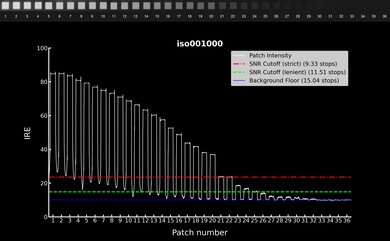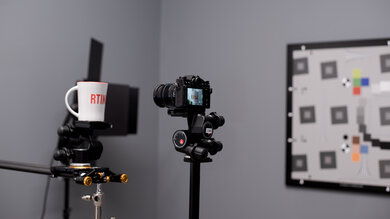
So you're on a hike and reach an amazing lookout, and you want to capture the moment, only to realize that all you've got on you is your phone. Sure, your smartphone will do in a pinch, but having a dedicated camera means capturing those stunning views with more clarity and detail. A good camera to bring on hikes or backpacking expeditions needs to be portable and, ideally, weather-sealed so you can shoot in all kinds of weather conditions without worry. Crop sensor mirrorless cameras are the ideal choice for a mix of image quality, portability, and durability, but some people may decide to give up the versatility of an interchangeable lens for the portability that comes with a fixed-lens point-and-shoot camera.
We've bought and tested over 115 cameras in our lab, and below, you'll find our recommendations for the best cameras for hiking and backpacking. If you don't care as much about the portability of your camera and want the best possible image quality, you can also check out our buying guide for the best cameras for landscape photography. On the flip side, if portability is your top priority, you can try the best cameras for travel or the best compact cameras. If you're a birding enthusiast, look at our best cameras for bird photography, too.
-
Best Camera For Hiking And Backpacking
Travel Photography8.2Landscape Photography8.1The Fujifilm X-T5 is the best camera for hiking that we've tested. It has a sturdy, weather-sealed body, a relatively portable design, and plenty of small APS-C lens options that make for a highly portable kit. Fujifilm's old-school dedicated exposure dials also give you more hands-on control over your settings. But the real highlight of this camera is its sensor—at 40.2 megapixels, it's the highest-resolution APS-C sensor on the market. It has excellent dynamic range, with enough resolving power to give you plenty of room to crop in and adjust your photos.
The camera also features in-body image stabilization (IBIS), which can help you capture stable handheld shots at slower shutter speeds, so you can leave the bulky tripod at home. Beyond that, the X-T5 has a fantastic battery life for a mirrorless model, making it a great choice for long hikes and backpacking excursions. If you want to save some money, its predecessor, the Fujifilm X-T4, is still a great choice, though it uses a lower-resolution sensor and is a tad bigger and heavier.
-
Best Mid-Range Camera For Hiking And Backpacking
Travel Photography7.5Landscape Photography7.6If you want something a little easier on the wallet, check out the OM SYSTEM OM-5. A Micro Four Thirds (MFT) camera like this is a great choice for hikes thanks to its portable size and smaller lenses. The OM-5 is a well-built camera with good ergonomics for its size and a weather-sealed body that the manufacturer advertises as dustproof, splashproof, and freezeproof.
It also has some neat extra features, including computational photography modes to get higher-resolution composite images or make it easier to get long-exposure shots. To top it off, its five-axis IBIS system is highly effective for getting steadier shots without a tripod. The battery life isn't as good as on the Fujifilm X-T5, but this is still a fantastic choice for adventurous photographers who want something compact and feature-rich without spending a fortune. If you can find one for less, the Olympus OM-D E-M5 Mark III is the OM-5's predecessor and a great cheaper alternative with a largely identical feature set. However, it uses an older processor and lacks certain features, like LiveND.
-
Best Entry-Level Camera For Hiking And Backpacking
Travel Photography7.8Landscape Photography7.9The Fujifilm X-T30 II is another great mid-range option for hiking. While it doesn't have IBIS, it's just as small and lightweight as the OM SYSTEM OM-5, making it easy to hike and travel with. Unlike the OM SYSTEM, it uses an APS-C sensor, so it's a bit better suited to low-light shooting. It's also compatible with a wide range of different lenses. There are also plenty of portable and high-quality primes for Fuji's X mount, though they won't be as compact as Micro Four Thirds options.
That said, there's a trade-off in build quality here. This model has no weather sealing, so you must be more careful in adverse weather conditions. On the upside, its dedicated exposure dials make adjusting settings very easy, and you can play with its preset film simulation profiles to change up the look of your JPEGs in-camera. Ultimately, if you can live without weather sealing or built-in stabilization, this is an excellent little camera for the money. It's worth noting that its follow-up, the Fujifilm X-T50, is out now and includes improvements like a higher-resolution sensor and IBIS, but it's significantly pricier, making the X-T30 II a better deal for most photographers in this price range.
-
Best Budget Camera For Hiking And Backpacking
Travel Photography7.6Landscape Photography7.6If you're on an even tighter budget, the Olympus OM-D E-M10 Mark IV is one of the best-value options for hiking and backpacking. It's a step down from the OM SYSTEM OM-5 and the Olympus OM-D E-M5 Mark III in the Olympus lineup, but it offers many of the same features that make the OM-5 a standout for backpackers and adventure-seekers.
For one, it's incredibly lightweight and portable, and since it's part of the MFT system, you'll have plenty of compact and relatively affordable lens options to choose from. On top of that, it's one of the few budget options to feature IBIS, making it easier to get clear handheld shots at slower shutter speeds. While it doesn't have a very effective autofocus system, it's still a great choice if you want something simple and compact on a budget. Another good choice at this price point is the Canon EOS R50, which is a tad cheaper and has better autofocus but lacks IBIS and is less portable overall. While the E-M10 Mark IV doesn't feel as well-built as pricier models and has no weather sealing, it checks a lot of boxes at a price that's hard to beat for those just getting started in photography.
-
Best Point-And-Shoot Camera For Hiking And Backpacking
Travel Photography7.3Landscape Photography8.4While an interchangeable lens camera will give you the best image quality and the most versatility, a point-and-shoot like the RICOH GR III is an excellent take-anywhere camera. It's incredibly compact, easily fitting into a jacket pocket or small bag, and thanks to a high-res APS-C sensor and a sharp built-in lens, it's tough to beat its size-to-image-quality ratio. Dynamic range is excellent on this thing, and its relatively wide aperture gives you some leeway in low light. The fixed 28mm full-frame equivalent lens is a great fit for landscapes and wider shots, but if you prefer a narrower field of view, the RICOH GR IIIx has a 40mm lens that may suit you better.
The camera's minimalist design makes it easy to shoot with, and it feels well-built overall, though it isn't weather-sealed to keep out dust and moisture. The fixed screen can also make it difficult to shoot at different angles. Of course, since it's so compact, it has a more limited battery life, so you may want to pack a spare battery or power bank for longer hikes. Still, if you want to eliminate the need for a bulkier kit without sacrificing image quality, this truly pocketable camera is the way to go.
Notable Mentions
- Fujifilm X-M5:
If you're after a mid-range option with as portable a footprint as possible, the Fujifilm X-M5 is even smaller than the Fujifilm X-T30 II. However, it comes with the big drawback of not having a viewfinder and having slightly more cramped ergonomics. Otherwise, they use the same sensor, so image quality is comparable.
See our review - OM SYSTEM OM-1 Mark II: The OM SYSTEM OM-1 Mark II shares many great features with the OM SYSTEM OM-5, including composite photo modes and IBIS, with the added benefit of a more rugged build and better ergonomics, not to mention a stacked sensor and better video features. However, it's notably bulkier and, with a higher price tag than the Fujifilm X-T5, is likely overkill for hiking. See our review
- Sony α7C II:
If you want full-frame image quality without the bulk, the Sony α7C II is the best option. It has an impressively compact design for a full-frame camera. That said, it still isn't as portable as the Fujifilm X-T5, especially when you factor in lens sizes, and it has a small viewfinder that's uncomfortable to shoot with.
See our review - Sony RX100 VII: The Sony RX100 VII is an excellent point-and-shoot camera with a more versatile zoom lens than the RICOH GR III. However, it's more expensive and uses a smaller sensor, resulting in worse overall image quality. See our review
Recent Updates
-
We added the Fujifilm X-M5 as a Notable Mention due to its incredibly portable size. We also renamed the 'Mid-Range' pick to 'Entry-Level' and the 'Upper Mid-Range' to 'Mid-Range' to more accurately reflect their respective market positions.
-
We added a comparison between the Fujifilm X-T30 II and the Fujifilm X-T50 to add more up-to-date market context for our picks.
-
Aug 13, 2024 : We added mention of the Canon EOS R50 as a potential alternative to the Olympus OM-D E-M10 Mark IV, as it's a bit cheaper and more widely available.
-
May 16, 2024 : We brushed up some of the text to bring the article up to date, including removing a reference to the older Fujifilm X-T4. Our top recommended cameras remain the same.
-
Mar 21, 2024 : We've reviewed the article to ensure the picks are up to date and touched up some of the text for clarity.
All Reviews
Our recommendations above are what we think are currently the best cameras for most people to buy for hiking and backpacking. We factor in the price, feedback from our visitors, and availability (no cameras that are difficult to find or almost& out of stock in the U.S.).
If you'd like to choose for yourself, here's the list of all our camera reviews. Be careful not to get caught up in the details. There is no single perfect camera. Personal taste, preference, and shooting habits will matter more in your selection.
Comments
Best Cameras For Hiking And Backpacking: Main Discussion
What do you think of our picks? Let us know below.
Looking for a personalized buying recommendation from the RTINGS.com experts? Insiders have direct access to buying advice on our insider forum.
Update: We’ve added a link to the newly-reviewed Keychron C1 Pro/C2 Pro in the Build Quality section of this review.
































































